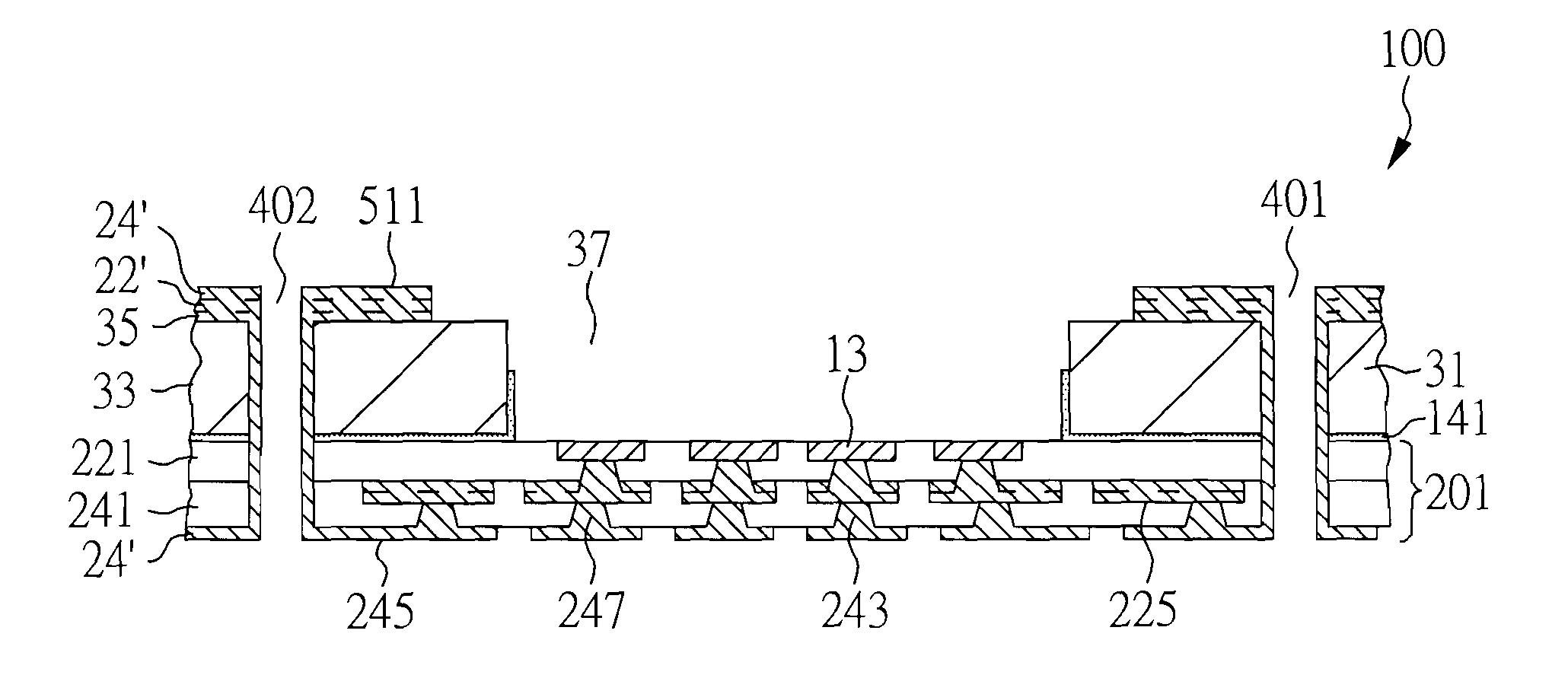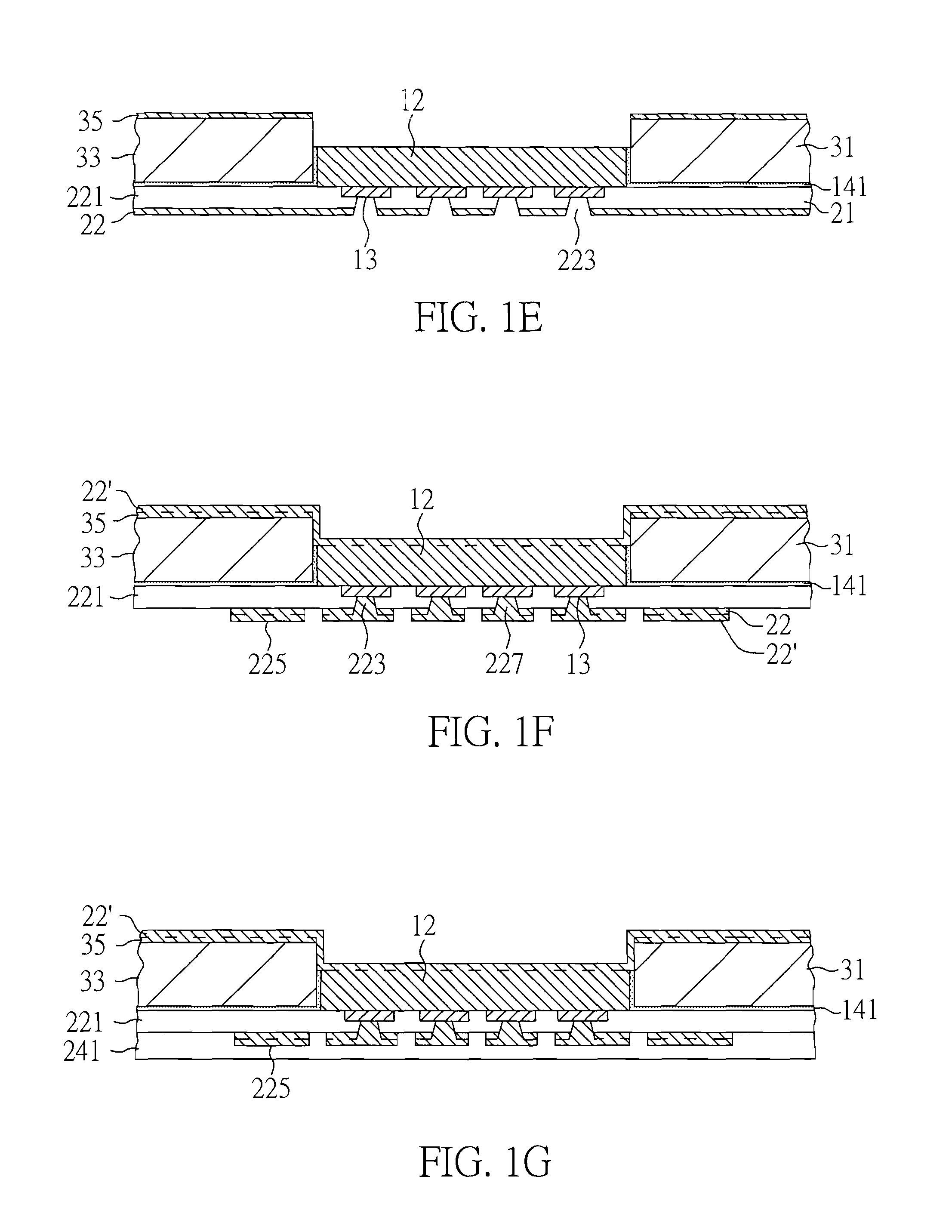Method of making cavity substrate with built-in stiffener and cavity
- Summary
- Abstract
- Description
- Claims
- Application Information
AI Technical Summary
Benefits of technology
Problems solved by technology
Method used
Image
Examples
embodiment 1
[0055]FIGS. 1A-1J are cross-sectional views showing a method of making a cavity substrate that includes electrical pads exposed from a cavity, a stiffener, an adhesive, a build-up circuitry in electrical connection with the electrical pads, terminals and plated through-holes that provide an electrical connection between the build-up circuitry and the terminals in accordance with one embodiment of the present invention.
[0056]FIG. 1A is a cross-sectional view of the structure with electrical pads 13 on sacrificial carrier 11. Sacrificial carrier 11 typically is made of copper, but other materials such as aluminum, alloy 42, iron, nickel, silver, gold, tin, combinations thereof, and alloys thereof are also doable. In consideration of process and cost, the thickness of sacrificial carrier 11 preferably ranges from 125 to 500 microns. Electrical pads 13 extend from sacrificial carrier 11 in the downward direction and are covered by sacrificial carrier 11 in the upward direction. Electric...
embodiment 2
[0079]FIGS. 2A-2G are cross-sectional views showing a method of making a cavity substrate that includes a stiffener, an adhesive, a build-up circuitry that includes conductive vias exposed from a cavity, terminals and plated through-holes that provide an electrical connection between the build-up circuitry and the terminals in accordance with another embodiment of the present invention.
[0080]For purposes of brevity, any description in above Embodiment is incorporated herein insofar as the same is applicable, and the same description need not be repeated.
[0081]FIG. 2A is a cross-sectional view of the structure with sacrificial carrier 11 laminated with metal layer 22 using dielectric layer 21 between sacrificial carrier 11 and metal layer 22. Sacrificial carrier 11 can be various metals such as copper, aluminum, alloy 42, iron, nickel, silver, gold, tin, combinations thereof, and alloys thereof. In order to prevent conductive vias subsequently formed in contact with sacrificial carri...
embodiment 3
[0090]FIGS. 3A-3H are cross-sectional views showing a method of making a cavity substrate that includes a stiffener, an adhesive, a dielectric layer, an interconnect substrate, conductive vias electrically connected to the interconnect substrate and exposed from a cavity, terminals and a plated through-hole that provides an electrical connection between the interconnect substrate and the terminals in accordance with yet another embodiment of the present invention.
[0091]For purposes of brevity, any description in above Embodiments is incorporated herein insofar as the same is applicable, and the same description need not be repeated.
[0092]FIG. 3A is a cross-sectional view of the structure with sacrificial carrier 11 laminated onto interconnect substrate 202 using dielectric layer 21, such as epoxy resin, glass-epoxy, polyimide and the like with a thickness of 50 microns. Interconnect substrate 202 includes first circuitry layer 214, first insulating layer 231, metal layer 25 and firs...
PUM
 Login to View More
Login to View More Abstract
Description
Claims
Application Information
 Login to View More
Login to View More - R&D
- Intellectual Property
- Life Sciences
- Materials
- Tech Scout
- Unparalleled Data Quality
- Higher Quality Content
- 60% Fewer Hallucinations
Browse by: Latest US Patents, China's latest patents, Technical Efficacy Thesaurus, Application Domain, Technology Topic, Popular Technical Reports.
© 2025 PatSnap. All rights reserved.Legal|Privacy policy|Modern Slavery Act Transparency Statement|Sitemap|About US| Contact US: help@patsnap.com



